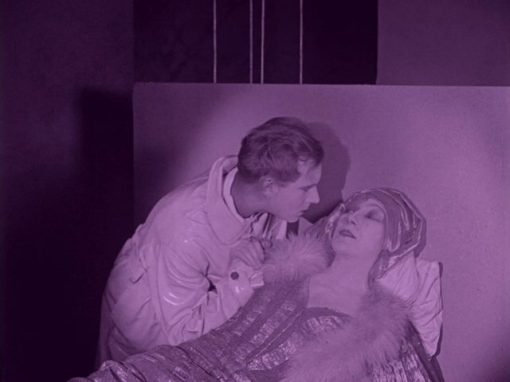Starting in 1927, Walter Benjamin began documenting the city of Paris with his Arcades Project. Unlike such studies before or after, he was concerned with the interior of Paris’ buildings. It was not the urban outside that provided the most interesting story to him, but rather the new inside corners that acted as a controlled simulacrum of what many considered to be “real Paris.” Like Benjamin, Marcel L’Herbier wanted to tell the story of Paris through interiors, and L’inhumaine, even if it does venture outside on occassion, tells the story of a city through a gothic, art-deco set that may not have had any basis in reality. It is a fantastical film, but it talks about things that exist in reality.
Claire Lescot is an aging but still beloved opera singer. She lives far away from the city in a rural but post-modern fortress that is occupied by her and a group of servants who hide under grotesque paper mache masks. Claire hosts a great deal of suitors, one of which is Einar Norsen. Einar is an impulsive and emotional scientist and when his longings for Claire aren’t reciprocated, suicide seems like the only response. Leaving her mansion, his car slips off a cliff. Einar can’t be found but he is presumed to be dead, which sends Claire reeling. A few days later, she is asked to identify his mutilated body. She finds him very much alive in a mansion as imposing as her, where he labors away on an instrument that could possibly broadcast her voice across the world.
While L’Herbier’s more celebrated follow-up L’Argent is loaded with energetic camera movements, it is a film that seems to have been composed by a gymnast. L’inhumaine, on the other hand, is controlled by a steadier hand, most likely the work of an architect. The space of Claire Lescot’s mansion is somewhat fictitious, her privacy is housed in an area that comes out of a fairy tale. Her fortress is one of a solitude, visibly marked as separate from the confines of the urban. Yet, within her lies all of the things that occupy the politics of the city: capitalism, colonization, and the body all partake in a dance (literally) in Claire’s fortress. Black servants perform entertainment for her as rich men bid for access towards her sexuality. Despite the negotiations that are happening all over her body, Claire is able to maintain some control. When the camera shifts to the top of the ceiling, her performance space takes on the appearance of a chess board, which complimented by the paper mache servants, imply that can manipulate things to her desires at will.
Of course, all of this is done to paint Claire as the “inhumane woman” of the title. The film intends to paint Einar as a tragic figure, one who feels great pain in being rejected. Of course, the irony is everybody feels the pain of this rejection. Threatening to kill yourself is not a very smart way to endear yourself to the person you’re interested in, but L’Herbier seems to insist that all the men here are playing on the same, potentially abusive field. Claire warms to Einar, ironically only after he fakes his death which coincides with a complete personality shift. The film makes a shift as well: it becomes a film about modernity and science, specifically the implications of Einar’s new broadcasting device. In one of the film’s most crucial scenes, Claire is able to see those who are listening to her broadcasted voice. She is greeted, at first, with two images, both of what many would consider “third world” countries. The “Other” appreciating her music provides her validation, but L’Herbier wants us to know that this is a cheap moment. Minutes later, she encounters a peasant woman who appears earlier in the film. Her pain is too much for Claire to bear.
L’Herbier loves sequences with audiences, and they seem to provide a nice opportunity for him to comment on and subvert our expectations. In L’Argent, the trial of a banker consumed by greed is treated with applause from an audience that is just as rich. The key scene here is when Claire’s concert following Einar’s (faked) death. The audience, as the intertitles tell us directly, are conflicted by her presence. Some continue to love her, while others are disgusted by her perceived indifference. This is all silly because 1) it was not her fault and 2) she wasn’t indifferent, but rather overwhelmed with grief. The chaos of the audience cuts through all of this, Claire can’t even present herself as either “humane” or “inhumane” (an awfully demanding binary!) because the public has already decided for themselves. It doesn’t matter how rich she is, as a woman, the audience is able to quickly wrestle back control of her persona. For all the modernity of Paris (or any western city), the celebrity woman is still scrutinized. Through this interior-based “story of Paris” L’Herbier has revealed a personal one. Claire is given a happy ending, but to a more perceptive viewer, it is a bitter one. She is granted access to an ideal heterosexual relationship, but considering how she was manipulated to get there, it can’t be healthy.





Leave a comment